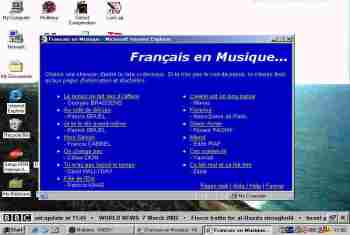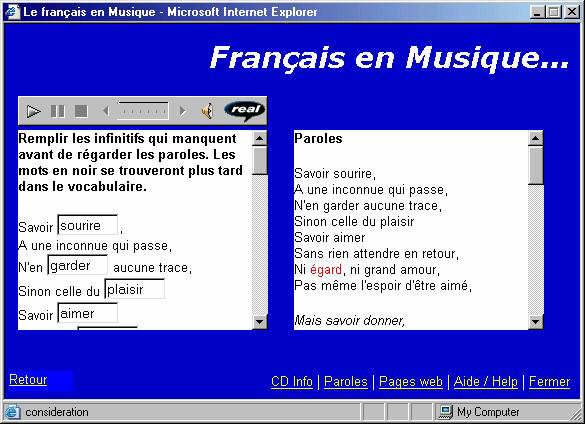
chucolproject2
sections on this page:
project outline:
My plan is to create CD-ROM which would allow secondary-school students (able Year 11 and A-Level students), as well as first year University students to learn French by listening to, and interacting with, contemporary popular French music.
format:
The CD-ROM will contain a number of HTML Files, which will allow the content to be viewed on the vast majority of machines and platforms. The audio files will be in the one of the following formats, depending on the related exercise's requirements. In both cases, the player will be embedded in the HTML page with an ActiveX command for ease of use and to avoid having two windows open on the screen.
- RealAudio - the vast majority of cases as the files are small and of potentially high quality
- Wave (compressed) - where it is necessary to randomly access a specific portion of the song very easily
The mixture of RealAudio and Wave has been provided mainly because a pilot version of this project that I designed had all the audio encoded as RealAudio and it is very difficult (and time-consuming) to re-convert these files back into wave format. Wave format is used for the short, randomly accessable, extracts as playback should be instantaneous whilst RealPlayer will insist on buffering a section first, highlighting its web-based origin.
In addition, transcripts of the lyrics will be provided for every song in HTML format in an IFRAME, with the ability to hover the mouse over an unusual word to see the meaning in the browser's status bar.
My designing on CD-ROM, it allows easy distribution to authorized users whilst making it more difficult for unauthorized users to gain access to the copyright material (recognising that CD burning is, increasingly, an issue). It means that school pupils could, potentially, take the CD-ROM home, borrowed from the school, without needing to spend hours online and waiting for large downloads (such as the Wave files). It would also be possible, although it will not be done for this project, to supply a zipped ISO image of the CD-ROM on a password-protected webserver for a user to download once and then use to burn their own copy of the CD-ROM.
design:

Introductory screen - click on the image to view full-size
The first HTML file loaded (index.htm) causes a smaller window of size 350x525 pixels to display with the list of available songs [above]. This smaller window (which has only a status bar and no other toolbars) is used to enable the content to be displayed accurately, whatever the user's monitor resolution.
Clicking a song title causes that song's lyrics to load on the right-hand side of the window, with the exercises and the embedded player on the left. In the case of some exercises where it is necessary to fill a word in a gap, for example, the lyrics are not displayed until the user requests them, to attempt to prevent cheating while still leaving the user in control of what he/she can see.

A sample of one exercise - click on the image to view
full size. Note how the meaning of the word égard is shown in the
status bar when the mouse is over it and how the user here is checking
their answers against the full version of the lyrics. You can also see
the embedded RealPlayer.
content
The exercises vary from gap-filling to quizzes which are marked by the computer to writing a short essay about a theme in the song which is submitted online and, after verification by myself could be displayed on a website, since children tend to like having their work displayed. The more technically demanding quizzes have been written by myself in JavaScript or adapted from existing scripts in free internet-based script archives.
minimum system requirements:
Because the project uses a lot of new technology, it is hardly surprising that it carries a fairly modern system to run it. In particular the user will need:
- An Internet Browser with full support for JavaScript 1.3* and the
IFRAME tag. (Preferably, although not necessarily, Microsoft Internet
Explorer 5 or later)
* - If you can see today's date at the very top of this page, your browser does support JavaScript 1.3 correctly. - RealPlayer (or other player able to play RealAudio files) version G2 or later (version 8 is preferable).
- A CD-ROM drive
- Soundcard and speakers/headphones
extending the work...
There are a number of ways in which the project could be improved if time and technology (or rather the average language student's access to the technology) allowed. In particular, I would like to rewrite the way that it handles the music using SMIL. This would allow for the text to scroll on screen as the music is playing. At the moment, however, it has two main drawbacks: it is only correctly supported by RealPlayer 8 and also there is no way at present of embedding JavaScript into the SMIL document as you can with HTML and so it would be impossible to allow vocabulary to be displayed in the status bar when the mouse hovers over it, for example.
It must also be recalled that the target audience for the CD-ROM (although it could not be published for copyright reasons) would be Secondary Schools. With the current funding crisis, many of these are lacking in new technology and would find the system requirements of this software impossible to meet on more than a handful of machines - no good when you have 30 in a class! I wanted, therefore, to develop a way for them to play the songs on a multimedia PC but allow the exercises to be undertaken on the very many redundant BBC Master B and Acorn computers that are to be found in British schools. It was from this desire that I wrote a short BBC Basic program which simulates a part of one of the exercises. I will not be developing this further but will leave the source code available on this site when I have tested it for anybody interested in these very good machines to take over.
© Dominic Smith
Email: dom@domsmith.co.uk
Trademarks acknowledged.